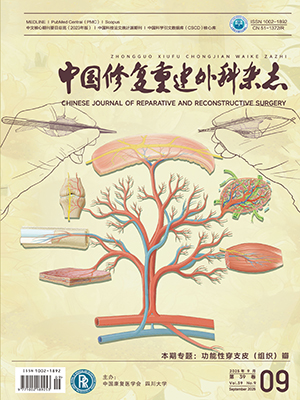Objective To explore the effects of bone marrow mesenchymal stem cells (BMSCs) transfected with adenovirus hepatocyte growth factor (Ad-HGF) on wound repair in diabetic rats. Methods BMSCs from male Wistar rats were isolated by density gradient centrifugation, cultured, and transfected with Ad-HGF. The multi pl icity of infection was 100. Diabetic models were establ ished in 20 female Wistar rats by diets in high fat and sugar plus intraperitoneal injection of
streptozotocin (30 mg/kg). Then 2 full-thickness skin wounds (approximately 1.5 cm in diameter) were made on the dorsum. The rats were randomly divided into 4 groups (n=5 rats). After wounding, the 0.3 mL suspensions of BMSCs (group A), Ad- HGF (group B), BMSCs transfected with Ad-HGF (group C), and PBS (group D) were injected directly into the derma of wounds. The transverse diameter and longitudinal diameter of wound were measured at 21 days after treatment. At 7 days and 28 days after treatment, HE staining was performed to evaluate wound heal ing. The contents of hydroxyprol ine and advanced glycosylation end products (AGEs) in the wounds were measured by enzyme l inked immunosorbent assay and fluorospectrophotometer, respectively, at 3, 7, 14, and 28 days after treatment. Results At 21 days after treatment, the wounds almost healed in group C, and the transverse diameter and longitudinal diameter were 0 and (0.110 ± 0.024) cm, respectively. But the wounds healed partially in groups A, B, and D, and the transverse diameter and longitudinal diameter were (0.470 ± 0.051) cm and (0.590 ± 0.041) cm, (0.390 ± 0.042) cm and (0.480 ± 0.032) cm, and (0.700 ± 0.068) cm and (0.820 ± 0.068) cm, respectively. There were significant differences in wound heal ing between group C and groups A, B, and D (P lt; 0.05). The wound heal ing time of group C [(20.5 ± 1.9) days] was significantly shorter (P lt; 0.05) than those of groups A, B, and D [(28.3 ± 1.9), (25.9 ± 2.3), and (36.6 ± 5.1) days]. At 7 days, the HE staining showed that evident epidermis transportation, collagen formation, and leukocytes infiltration were observed in group C. At 28 days, the HE staining showed that the epidermis in group C was significantly thinner and more regular than those in other groups, and the decreased collagen and many small vessels were observed in group C. The content of hydroxyprol ine in group C was higher than those in groups A, B, and D at 7 days and 14 days (P lt; 0.05). The contents of AGEs in group C was lower than those in groups A, B, and D at 14 days and 28 days (P lt; 0.05). Conclusion Transplantation of BMSCs transfected with Ad-HGF can accelerate the wounds repair in diabetic rats.
Citation: HA Xiaoqin,YIN Qiang,DONG Fang,JIA Qinghua,LV Tongde.. STUDY ON BONE MARROW MESENCHYMAL STEM CELLS TRANSFECTED WITH ADENOVIRUS HEPATOCYTE GROWTH FACTOR GENE PROMOTING WOUNDS REPAIR IN DIABETIC RATS. Chinese Journal of Reparative and Reconstructive Surgery, 2010, 24(12): 1520-1524. doi: Copy
Copyright © the editorial department of Chinese Journal of Reparative and Reconstructive Surgery of West China Medical Publisher. All rights reserved




